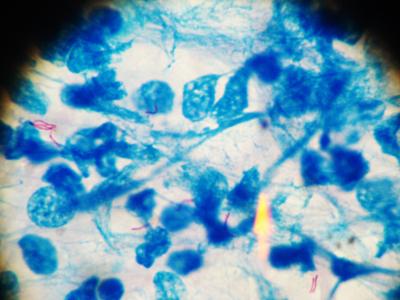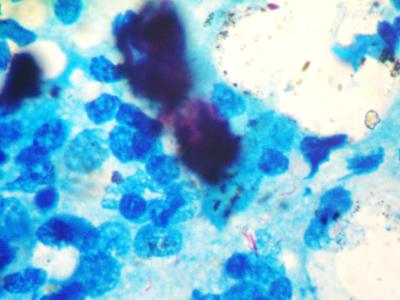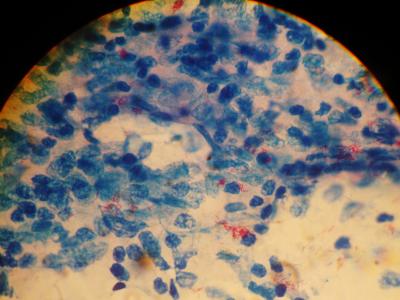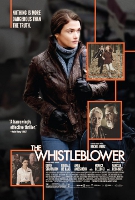Diagnosis of disseminated Tuberculosis in bone marrow aspirates - Results of a second study
Dr. Alexander von Paleske --- 03.09. 2012 ---
Department of Haematology: Alexander von Paleske, MD, FA(Med), FA (Haem / Onc); Owen Chivima, SCMLT
National TB Reference Laboratory: Barbara Murwira, CMLS; Thembela Masuku, SMLS; Tanaka Sakubani, SMLS; Regina Bhebe, SMLS.
Mpilo-Hospital
Teaching Hospital of the University of Zimbabwe
Bulawayo/Zimbabwe
Africa
Introduction
Disseminated /miliary TB is a life threatening form of Tuberculosis, not rarely see in HIV-AIDS patients with a CD4 count below 200/ul.
The diagnosis is often made on clinical grounds. Chest X-rays may show involvement of the lungs, however a final diagnosis is often difficult.
Disseminated / miliary TB can involve the bone marrow.



Disseminated TB: A few AAFB's (red) in three bone marrow aspirates - Photos Dr. v. Paleske
A few studies albeit with small numbers have shown, that bone marrow aspirates may thus play a useful role in the diagnosis.
In disseminated / miliary TB it is difficult to obtain a specimen for culture, as the sputum results are often negative, and invasive procedures like lung- or liver aspirates carry a considerable risk for the patient.
The bone marrow aspirate, however carries a comparatively low risk.
We have reported the results of our first study: 312 bone marrow aspirates, (186 from adults, age 15 - 86 years, and 126 from children age 2 months – 14 years) were obtained during the period from 1st May 2010 to 30th April 2011
We report here the results of a follow up 2nd study
Patients and Methods
318 bone marrow aspirates from patients with the diagnosis of anaemia, severe granulocytopenia, thrombocytopenia, bicytopenia, pancytopenia or disseminated TB, referred to Mpilo Hospital, Department of Haematology during the period from 1st May 2011 to 30th April 2012, were obtained:.
-254 adults, age 16 - 86 years (median age 39 years), 164 female and 90 male
- 64 children age 2 months – 15 years (median age 3 years)
38 female, 26 male.
Bone marrow smears were stained in a conventional way, in addition one slide was stained with Ziehl-Neelsen for detection of AAFBs (Alcohol and Acid Fast Bacilli), and the bone marrow specimen, collected in an EDTA-tube (Full blood count tube), then sent for TB-culture (solid and liquid media).
Results
Altogether 46 / 318 (14,46 %) specimens were diagnosed TB-positive ( TB-Culture and / or AAFB’s seen under the microscope)
- 6 / 64 in children ( 9..37 %)
- 40 / 254 in adults ( 15.74%)
TB-culture positive of all tuberculosis diagnoses were 35 / 46 (76.08%)
- 30 Mycobacteria tuberculosis
- 5 Mycobacteria other than m. tuberculosis, MOTT (4 in adults, 1 in children)
AAFB’s positive under the microscope were:
- 17 / 46 (36.95%) of which 11 were culture negative. All 11 patients, whose specimens were culture negative, had already been started on anti TB-treatment (ATT) before the bone marrow aspirate was performed.
Patients, whose specimens were AAFBs microscopically positive, were all at an advanced stage of HIV-disease.
Discussion
This study confirms, that bone marrow aspirates turn out to yield a comparatively high rate of TB-positive results in a setting with a high incidence of HIV-disease and TB. The results are similar to those in the first study (15.75% positive TB- results in adults vs. 14.4% in the previous study) , however the percentage of microscopically AAFB-positive specimens rose from 12.12% to 36.95%. The detection of AAFB’s is extremely important for a rapid diagnosis.
The higher number is at least partly due to the fact, that an increasing number of patients has been sent for bone marrow aspirate to confirm the diagnosis of suspected disseminated TB.
This study contains a considerable number of specimens, which were AAFB’s positive, however culture negative. This emphasizes the need, to perform a bone marrow aspirate before a patient is started on ATT – if possible.
However It remains unclear, how high the detection rate in disseminated / miliary TB with bone marrow involvement truly is.
PCR - not available here - has shown to increase the yield compared to culture.
The now recommended Xpert MTB/ RIF-test may be quite useful for rapid detection of TB in bone marrow aspirates.
However,it cannot replace the need for TB culture to detect MDR- and XDR-TB, as it can only detect Rifampicin- resistance, which alone is not sufficient to qualify for MDR-TB.
Moreover, this test gives a false negative result, if resistance is present not aginst Rifampicin, but instead against two of the other drugs in use for first line TB-treatment (see Lancet 2011 Vol 377, 1467) .
Furthermore this test offers nothing for the detection of XDR-TB.
Not to forget the costs of that test: roughly ten times higher than the conventional tests.
 Diagnosis of disseminated Tuberculosis in bone marrow aspirates
Diagnosis of disseminated Tuberculosis in bone marrow aspirates
 Lymph node aspirates in Tuberculosis-Diagnosis: New challenges, new solutions – a study of 156 patients
Lymph node aspirates in Tuberculosis-Diagnosis: New challenges, new solutions – a study of 156 patients
 Lymph node aspirates in Tuberculosis-Diagnosis: New challenges, new solutions – a second study of 545 patients
Lymph node aspirates in Tuberculosis-Diagnosis: New challenges, new solutions – a second study of 545 patients
 Lymph node aspirates in Tuberculosis-Diagnosis - A third study of 549 patients
Lymph node aspirates in Tuberculosis-Diagnosis - A third study of 549 patients
References
Görgün Akpek, Shing M. Lee, David R. Gagnon, Timothy P. Cooley, and Daniel G. Wright
Bone Marrow Aspiration, Biopsy, and Culture in the
Evaluation of HIV-Infected Patients for Invasive
Mycobacteria and Histoplasma Infections -
American Journal of Hematology 67:100–106 (2001)
Lombard EH, Victor T, Jordaan A, van Helden PD.
The detection of Mycobacterium tuberculosis in bone marrow aspirate using the polymerase chain reaction. Tuber Lung Dis. 1994 Feb;75(1):65-9.
K. Ritis, S. Giaglis, S. Rafail, E. Alepopoulou, V. Tsironidou, D. Tzoanopoulos, M. Speletas,S. Ktenidou-Kartali, P. Sideras, G. Kartalis -
Diagnostic usefulness of bone marrow aspiration material
for the amplification of IS6110 insertion element in extrapulmonary
tuberculosis: comparison of two PCR techniques -
Int J Tuberc Lung Dis 9(4):455–460 (2005)
.
E-Mail: avonpaleske@yahoo.de
Department of Haematology: Alexander von Paleske, MD, FA(Med), FA (Haem / Onc); Owen Chivima, SCMLT
National TB Reference Laboratory: Barbara Murwira, CMLS; Thembela Masuku, SMLS; Tanaka Sakubani, SMLS; Regina Bhebe, SMLS.
Mpilo-Hospital
Teaching Hospital of the University of Zimbabwe
Bulawayo/Zimbabwe
Africa
Introduction
Disseminated /miliary TB is a life threatening form of Tuberculosis, not rarely see in HIV-AIDS patients with a CD4 count below 200/ul.
The diagnosis is often made on clinical grounds. Chest X-rays may show involvement of the lungs, however a final diagnosis is often difficult.
Disseminated / miliary TB can involve the bone marrow.



Disseminated TB: A few AAFB's (red) in three bone marrow aspirates - Photos Dr. v. Paleske
A few studies albeit with small numbers have shown, that bone marrow aspirates may thus play a useful role in the diagnosis.
In disseminated / miliary TB it is difficult to obtain a specimen for culture, as the sputum results are often negative, and invasive procedures like lung- or liver aspirates carry a considerable risk for the patient.
The bone marrow aspirate, however carries a comparatively low risk.
We have reported the results of our first study: 312 bone marrow aspirates, (186 from adults, age 15 - 86 years, and 126 from children age 2 months – 14 years) were obtained during the period from 1st May 2010 to 30th April 2011
We report here the results of a follow up 2nd study
Patients and Methods
318 bone marrow aspirates from patients with the diagnosis of anaemia, severe granulocytopenia, thrombocytopenia, bicytopenia, pancytopenia or disseminated TB, referred to Mpilo Hospital, Department of Haematology during the period from 1st May 2011 to 30th April 2012, were obtained:.
-254 adults, age 16 - 86 years (median age 39 years), 164 female and 90 male
- 64 children age 2 months – 15 years (median age 3 years)
38 female, 26 male.
Bone marrow smears were stained in a conventional way, in addition one slide was stained with Ziehl-Neelsen for detection of AAFBs (Alcohol and Acid Fast Bacilli), and the bone marrow specimen, collected in an EDTA-tube (Full blood count tube), then sent for TB-culture (solid and liquid media).
Results
Altogether 46 / 318 (14,46 %) specimens were diagnosed TB-positive ( TB-Culture and / or AAFB’s seen under the microscope)
- 6 / 64 in children ( 9..37 %)
- 40 / 254 in adults ( 15.74%)
TB-culture positive of all tuberculosis diagnoses were 35 / 46 (76.08%)
- 30 Mycobacteria tuberculosis
- 5 Mycobacteria other than m. tuberculosis, MOTT (4 in adults, 1 in children)
AAFB’s positive under the microscope were:
- 17 / 46 (36.95%) of which 11 were culture negative. All 11 patients, whose specimens were culture negative, had already been started on anti TB-treatment (ATT) before the bone marrow aspirate was performed.
Patients, whose specimens were AAFBs microscopically positive, were all at an advanced stage of HIV-disease.
Discussion
This study confirms, that bone marrow aspirates turn out to yield a comparatively high rate of TB-positive results in a setting with a high incidence of HIV-disease and TB. The results are similar to those in the first study (15.75% positive TB- results in adults vs. 14.4% in the previous study) , however the percentage of microscopically AAFB-positive specimens rose from 12.12% to 36.95%. The detection of AAFB’s is extremely important for a rapid diagnosis.
The higher number is at least partly due to the fact, that an increasing number of patients has been sent for bone marrow aspirate to confirm the diagnosis of suspected disseminated TB.
This study contains a considerable number of specimens, which were AAFB’s positive, however culture negative. This emphasizes the need, to perform a bone marrow aspirate before a patient is started on ATT – if possible.
However It remains unclear, how high the detection rate in disseminated / miliary TB with bone marrow involvement truly is.
PCR - not available here - has shown to increase the yield compared to culture.
The now recommended Xpert MTB/ RIF-test may be quite useful for rapid detection of TB in bone marrow aspirates.
However,it cannot replace the need for TB culture to detect MDR- and XDR-TB, as it can only detect Rifampicin- resistance, which alone is not sufficient to qualify for MDR-TB.
Moreover, this test gives a false negative result, if resistance is present not aginst Rifampicin, but instead against two of the other drugs in use for first line TB-treatment (see Lancet 2011 Vol 377, 1467) .
Furthermore this test offers nothing for the detection of XDR-TB.
Not to forget the costs of that test: roughly ten times higher than the conventional tests.
References
Görgün Akpek, Shing M. Lee, David R. Gagnon, Timothy P. Cooley, and Daniel G. Wright
Bone Marrow Aspiration, Biopsy, and Culture in the
Evaluation of HIV-Infected Patients for Invasive
Mycobacteria and Histoplasma Infections -
American Journal of Hematology 67:100–106 (2001)
Lombard EH, Victor T, Jordaan A, van Helden PD.
The detection of Mycobacterium tuberculosis in bone marrow aspirate using the polymerase chain reaction. Tuber Lung Dis. 1994 Feb;75(1):65-9.
K. Ritis, S. Giaglis, S. Rafail, E. Alepopoulou, V. Tsironidou, D. Tzoanopoulos, M. Speletas,S. Ktenidou-Kartali, P. Sideras, G. Kartalis -
Diagnostic usefulness of bone marrow aspiration material
for the amplification of IS6110 insertion element in extrapulmonary
tuberculosis: comparison of two PCR techniques -
Int J Tuberc Lung Dis 9(4):455–460 (2005)
.
E-Mail: avonpaleske@yahoo.de
onlinedienst - 2. Sep, 22:58 Article 6816x read
















































